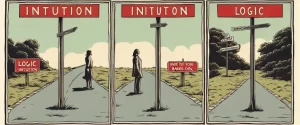——The Art of Mental Training by D.C. Gonzalez & The Power of Habit by Charles Duhigg

In today’s fast-paced world, where external stressors and distractions are constant companions, our ability to focus, set goals, and develop strong habits has become paramount to our success and personal growth. Recognizing this importance, numerous self-help books have emerged, each presenting their own unique perspective on training the mind and cultivating effective habits. Among these offerings, two prominent books stand out as influential works in the field: “The Art of Mental Training” by D.C. Gonzalez and “The Power of Habit” by Charles Duhigg.
The Art of Mental Training” offers readers a comprehensive guide to strengthen their mental resolve and tap into their full potential. Drawing on his experience as a mental training coach for professional athletes, D.C. Gonzalez shares practical tools and techniques to enhance focus, develop a winning mindset, and overcome obstacles in pursuit of one’s goals. By incorporating elements of neuroscience, psychology, and mindfulness, Gonzalez empowers readers to take control of their thoughts, emotions, and actions, ultimately shaping their destiny.
On the other hand, Charles Duhigg’s “The Power of Habit” delves into the intricate science behind habitual behaviors, exploring how they are formed, why they persist, and how they can be changed. Through captivating anecdotes and meticulous research, Duhigg elucidates the power of habit loops and teaches readers how to identify cues, change routines, and cultivate new habits that align with their desired outcomes. By understanding the science of habits, Duhigg equips readers with the knowledge to transform their lives from the inside out.
While both books share a common aim of enhancing mental faculties and establishing productive routines, they employ distinct methodologies and philosophies. Gonzalez’s approach is rooted in the domain of sports psychology, emphasizing the importance of mental imagery, self-talk, and visualization to achieve peak performance. On the other hand, Duhigg takes a broader perspective, incorporating case studies from a variety of industries, ranging from corporate America to personal transformations.
This comparative study aims to delve deeper into the similarities and differences between these two literary works, exploring the underlying principles of mental training, habit formation, and personal development. Through a critical analysis of their respective methodologies, scientific foundations, and real-life applications, we aim to uncover the strengths and limitations of each book, ultimately providing readers with a comprehensive understanding of how to optimize their mental faculties and harness the power of habits.
By examining “The Art of Mental Training” and “The Power of Habit” side by side, we seek to highlight the nuanced approaches offered by Gonzalez and Duhigg, showcasing the rich tapestry of knowledge and wisdom that can be gleaned from these transformative works. Whether you are an athlete striving for peak performance, a professional aiming to excel in your career, or an individual seeking personal growth, this comparative study aims to unlock the secrets to harnessing the mind’s potential and establishing life-changing habits. So, come join us on this insightful journey as we explore the art of mental training and the power of habit.
Brief Summary of Two Books
The Art of Mental Training by D.C. Gonzalez
The book “The Art of Mental Training” by D.C. Gonzalez is a comprehensive guide that explores the power of your mind and provides practical techniques to improve mental strength and focus. The author emphasizes the importance of mental toughness in achieving success in various areas of life, such as sports, business, and personal growth.
Gonzalez begins by explaining the concept of mental training and how it can enhance your performance and overall well-being. He introduces the reader to the idea of the “inner game,” which refers to the mental state that has a significant impact on your external actions and results.
The book then delves into various strategies and exercises to develop mental discipline and concentration. Gonzalez introduces techniques like visualization, goal setting, affirmations, and adopting a positive mindset. These practices help readers establish a clear vision for success, overcome limiting beliefs, and develop resilience in the face of challenges.
Furthermore, Gonzalez provides insights and tips on managing emotions, developing self-confidence, and improving focus. He emphasizes the importance of controlling one’s thoughts and emotions to maintain peak performance and avoid distractions.
“The Art of Mental Training” also explores the role of self-talk and the subconscious mind in shaping our behavior and outcomes. Gonzalez highlights the significance of maintaining a supportive inner dialogue and creating empowering beliefs that align with our goals.
Throughout the book, the author shares personal anecdotes, case studies, and exercises to reinforce the concepts covered. He also addresses common misconceptions about mental training and offers solutions to common obstacles that hinder progress.
In conclusion, “The Art of Mental Training” is a practical guide that equips readers with the tools to develop mental strength, focus, and resilience. It provides a blueprint for optimizing performance in various domains of life by harnessing the power of the mind.
The Power of Habit by Charles Duhigg
The Power of Habit” by Charles Duhigg explores the science behind habits and how they shape our lives. Duhigg delves into the cycle of habits – the cue, routine, and reward – and breaks it down into its components to understand how habits work and how they can be changed. He identifies the power of habit in individual lives, organizations, and society as a whole.
The book is divided into three parts. In the first part, Duhigg explains the science of habits and provides many examples of how habits influence personal and collective behaviors. He presents various studies and real-life stories to demonstrate the power of habits in different areas, such as decision-making, health, productivity, and social movements.
The second part focuses on the formation and reprogramming of habits. Duhigg discusses techniques and strategies to identify and modify habits, presenting cases of individuals who were able to overcome destructive habits and create positive change in their lives. He emphasizes the importance of understanding the cues and rewards associated with habits to effectively change them.
The final part explores the role of habits in organizations and larger societal contexts. Duhigg reveals how companies, such as Procter & Gamble and Target, use consumer habits to shape their marketing strategies. He also examines how habits can influence social movements and societal changes, citing examples like the civil rights movement and anti-smoking campaigns.
Overall, “The Power of Habit” provides readers with a deep understanding of how habits operate and the potential they hold for personal and societal transformation. Duhigg not only explains the science behind habits but also offers practical advice on how to identify and change them, allowing readers to harness the power of habits to improve their lives.
Comparison between Two Books

Similarities in self help
The two books, “The Art of Mental Training” by D.C. Gonzalez and “The Power of Habit” by Charles Duhigg, both offer valuable insights and techniques for self-help and personal growth. Here are some similarities between the two books’ approaches to self-help:
1. Emphasis on training the mind: Both books recognize the significance of mental conditioning and emphasize the importance of training the mind to achieve desired goals. Whether it is developing mental toughness or changing habits, both authors stress the power of the mind in transforming oneself.
2. Practical techniques and strategies: Both books provide practical techniques and strategies that readers can implement to improve their mental abilities and change their behavior. Whether it is visualizations, goal-setting, or habit loops, both authors offer specific tools to help individuals take actionable steps towards self-improvement.
3. Focus on creating positive habits: Both books explore the idea of habits and their impact on our lives. They emphasize the importance of identifying and cultivating positive habits that support personal growth and success. By understanding and harnessing the power of habits, individuals can begin to create lasting positive changes in their lives.
4. Psychological insights: Both authors draw from psychological research and studies to explain the underlying mechanisms behind our thoughts, behaviors, and habits. This scientific approach provides readers with a deeper understanding of the psychological processes at play and offers evidence-based explanations for the effectiveness of various self-help techniques suggested in the books.
5. Case studies and real-life examples: Both books incorporate case studies and real-life examples to illustrate the principles and techniques discussed. By sharing stories of individuals who have successfully applied these strategies, readers can gain inspiration and insight into how they can apply the teachings to their own lives.
Overall, “The Art of Mental Training” and “The Power of Habit” share common ground in their belief in the power of the mind, the importance of practical strategies, and the value of positive habits. Through their respective approaches, both books aim to empower readers to take control of their own lives and achieve personal growth and success.
Divergences in self help
The Art of Mental Training by D.C. Gonzalez and The Power of Habit by Charles Duhigg are both popular self-help books that delve into the realm of personal development. While they share similarities in terms of empowering individuals to take control of their actions and thoughts, there are key divergences in their approaches to self-help.
One notable divergence lies in the scope of the topics covered. The Art of Mental Training primarily focuses on honing one’s mental skills, particularly in the realm of sports performance. Gonzalez explores techniques such as visualization, goal setting, and focus enhancement specifically targeting athletes. On the other hand, The Power of Habit takes a broader view, examining the formation and transformation of habits in various aspects of life, including personal, professional, and societal contexts. Duhigg provides strategies and insights that can be applied by anyone seeking to change their habits, not just athletes.
Additionally, the authors’ approaches differ in terms of depth and scientific backing. The Art of Mental Training often provides practical and straightforward strategies based on personal experiences and anecdotes, making it easily accessible and relatable to readers. While Gonzalez incorporates some psychological principles, the book predominantly relies on his personal expertise as a sports performance coach. In contrast, The Power of Habit offers a more in-depth exploration of the science behind habit formation. Drawing from extensive research and case studies, Duhigg showcases the neurological, psychological, and social factors that underpin habit formation and provides a more rigorous analysis of the subject matter.
Furthermore, the writing styles of the two authors differ significantly. Gonzalez’s book is characterized by its motivational tone and concise, actionable advice. He employs a direct and straightforward approach, often using sports-related metaphors to drive his points home. In contrast, Duhigg’s writing style in The Power of Habit is more journalistic in nature, delving into real-life stories and examples to illustrate his concepts. Duhigg introduces readers to a range of relatable narratives, making the book engaging and captivating.
In conclusion, while both The Art of Mental Training and The Power of Habit offer guidance on personal development, they diverge in terms of their focus, depth, and writing style. Gonzalez’s book centers on mental training techniques specifically for athletes, building on personal experiences, and practical advice. In contrast, Duhigg’s book explores habits more broadly and delves into the scientific underpinnings of habit formation, employing a journalistic storytelling style. Despite their differences, both books provide valuable insights and strategies for individuals seeking self-improvement.

Conclusion
Both “The Art of Mental Training” by D.C. Gonzalez and “The Power of Habit” by Charles Duhigg are highly regarded self-improvement books that offer valuable insights. The choice between the two ultimately depends on your personal preferences and the specific area you are looking to improve.
“The Art of Mental Training” focuses on enhancing mental toughness and developing a strong mindset for success. It provides practical techniques and exercises to develop mental resilience, overcome obstacles, and perform at your peak. If you are interested in improving your mental strength, achieving your goals, or excelling in a particular area of life, this book may be more suitable for you.
On the other hand, “The Power of Habit” delves into the science behind habits and how they shape our lives. This book explores how habits are formed, how they can be changed, and how they influence various aspects of our behavior, from personal productivity to organizational effectiveness. If you are interested in understanding the power of habits and learning strategies to create positive habits or break bad ones, this book would be a valuable choice.
Ultimately, both books offer valuable insights and practical advice for personal growth and improvement. It is advisable to read reviews, summaries, or sample chapters to get a better understanding of which book resonates more with your specific interests and goals.



